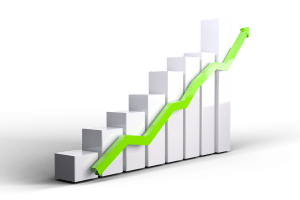Is your small business growing? Hopefully! After all, nothing is more frustrating than putting all your time and energy into your business and not generating an output equal to your input into your business. Not only that, but if you’re not growing enough to bring in enough revenue, you could be in trouble: according to the Chamber of Commerce, almost half of all small businesses that fail cite not having enough money coming in to pay employees and deal with other expenses as the main reason for their failure.
All that being said, not every small business is going to grow at the same rate – and not every growth rate is going to be right for your business at every point in time. It’s important to not only know your current rate of growth, but also what rate of growth to expect at the different stages of your business’ development.
What’s Your Growth Rate?
Why should you know your business’ growth rate? Well, it’s fairly simple: your company’s growth rate is an indicator of its profitability and sustainability. It not only shows how fast you are growing now, but can also help you project your growth over time. You can use this information to figure out how best to distribute your resources, to work out your operational and staffing plans, and also to show to investors or lenders.  There are different ways to calculate your growth rate, and you will still need to factor in things like marketing and insurance costs, but the following is a simple formula you can use to figure out your monthly revenue growth rate:
There are different ways to calculate your growth rate, and you will still need to factor in things like marketing and insurance costs, but the following is a simple formula you can use to figure out your monthly revenue growth rate:
{[(Second Month Revenue)-(First Month Revenue)]/(First Month Revenue)}
When looking at annual growth, as a general benchmark, companies should have an average of between 15% and 45% year-over-year growth. But that can all depend not only on your industry, but also on where your business is in its lifecycle. You don’t want to have unrealistic expectations, but on the other hand, you shouldn’t be limiting yourself! Sometimes aggressive or ambitious growth goals are achievable, but you need to know when to expect rapid growth.
How Fast Should You Be Growing?
One of the major things to consider when determining what your growth rate is – and what it should be – is the stage that your business is in. Have you just built it from the ground up, for example? If so, you’re going to have greater growth rates, as zero to any amount of revenue is a large increase. Take a look at the following growth rates to shoot for at every stage of your business:
- Hypergrowth – Spent any time in Silicon Valley? Then you might be familiar with this term, and its relation to booming tech startups. Achieving hypergrowth means that you’re growing at a rate of 2, 3, or even 4 times. This might sound impossible, but it is actually a fairly solid goal if you’re a new company. Think about this: if you’re just starting out and making $500 a month, shooting up to $2,000 a month is usually pretty achievable. If you’re making $25 million a year (well done, you!), then rocketing to $100 million a year probably isn’t going to happen. So, consider this hypergrowth stage as temporary, and think about what you should be shooting for after you make it past your first year.

Do you want to double your growth with rapid growth or do do you want a steady growth over time?
- Rapid growth – Even after your first year, you could still be doubling the size of your business every 12-18 months if things are really going well. This would be considered rapid growth, and could last into your second or even third year if you have aggressive growth goals. As you become more established, though, doubling your business is not the most realistic goal.
- Steady growth – Once you’ve been around for a bit longer, but less than 7 years or so, you should be thinking about settling into a steady growth stage. You can still be ambitious and shoot for around 50-75% year-over-year growth, but unless you’re marketing a new business, you’ve had an advertising breakthrough or there’s been a positive change in your product or service’s market, for example, you’re probably past the stage of doubling your business.
- Mature growth – If you’ve made it to the 7 year mark, congratulations! After all, after 10 years, only about a third of businesses have survived. If you’ve made it to this point, you’ve found a good place in the market – but that means that you should also expect your growth rate to be a lot slower at this point. Your goal should be anywhere from as low as 10% to around 25% growth, depending on how fast your market is growing. In most cases, the only way to go back to any of the above stages is to start innovating or change up your business model. If you add a new product or service, or find a new marketing channel, you could actually catapult yourself briefly back into the hypergrowth stage.
Increased Market Demand = Increased Growth

The above stages of growth are the most likely scenarios for the progression of your business over the years. But if you find a way to harness increased market demand for your product or services, you could speed up your growth rate. For example, the following might generate increased demand for your product or services:
- Entering an untapped market
- Adding new products or services to your existing products or services
- A competitor leaving your market
- Creating a new demand
- Consumers shifting their tastes toward a new type of product (think phone technology)
Remember, business growth is an ongoing process. Your goals for growth will (and should) change over time as your business matures. Growth will slow as you find your place in the market, but you can jumpstart it with innovation. Whatever your rate of growth right now, make sure that you have both long and short-term growth strategies in place. Know your growth rate and know where it’s likely to head, and you’ll be ready for whatever comes your way.
